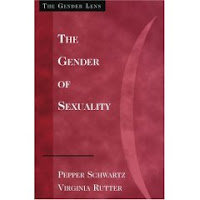 Another dear friend, sociologist and sex researcher Virginia Rutter, is revising her classic, The Gender of Sexuality, and is in search of blog, columns, books, and articles to reference in the new edition. Specifically, she is looking for 3rd-wavey writings on contemporary women’s sense of entitlement with regard to sexuality and sexual activity. I’ve suggested Lisa Johnson’s Jane Sexes It Up: True Confessions of Feminist Desire and also (though less 3rd-wavey) Ariel Levy’s Female Chauvinist Pigs. Does anyone have titles/articles/blog suggestions to add to the list? Feel free to post em here, and I will compose a mini-biblio in a post to share with all.
Another dear friend, sociologist and sex researcher Virginia Rutter, is revising her classic, The Gender of Sexuality, and is in search of blog, columns, books, and articles to reference in the new edition. Specifically, she is looking for 3rd-wavey writings on contemporary women’s sense of entitlement with regard to sexuality and sexual activity. I’ve suggested Lisa Johnson’s Jane Sexes It Up: True Confessions of Feminist Desire and also (though less 3rd-wavey) Ariel Levy’s Female Chauvinist Pigs. Does anyone have titles/articles/blog suggestions to add to the list? Feel free to post em here, and I will compose a mini-biblio in a post to share with all.

Friend plug alert! Two of my besties are doing very cool things in NYC this next week. On Sunday, Nov. 11, documentary filmmaker Ilana Trachtman will be screening her amazingly moving film, Praying with Lior, at theMargaret Mead Film Festival here at the Museum of Natural History. If you have the chance to see it–and Ilana is touring the country with it this year–do!
Then, on Monday, Nov. 12, Rebecca Wallace-Segall–the mastermind behind WritopiaLab–will be hosting a reading at the Lincoln Square B&N in which young writers from her workshops read from their work. Rebecca has also started a blog with her emerging writers, and is raising some interesting issues about youth, writing, imagination, and culture. For instance, she asks, “Can some video games (violent ones included) sometimes play a positive role in inspiring the minds of youth? Can they transcend their insidious time-wasting, violence-encouraging, obesity-making, inclinations?” Hmm…Marco?!
 Cool event going on in my neighborhood today, which sadly I can’t attend. But maybe someone else out there can, and can tell me about it!
Cool event going on in my neighborhood today, which sadly I can’t attend. But maybe someone else out there can, and can tell me about it!
Join filmmaker Therese Shechter as she takes a funny, moving and very personal journey into the heart of modern Feminism with her film, “I Was a Teenage Feminist.” Armed with a video camera and an irreverent sense of humor, Therese talks with Feminist superstars, rowdy frat boys, liberated Cosmo girls and Radical Cheerleaders, all in her quest to find out whether Feminism can still be a source of personal and political power. With music by Ani DiFranco, Lavababy, Gina Young, Moxie Starpark and the legendary Helen Reddy,”I Was A Teenage Feminist” redefines the F Word for a new generation. If you, like me, can’t be there, you can still click here to watch some clips from the film.
The Girls Project Film Series
Symphony Space
Sunday, November 4th
6:00 pm
2537 Broadway at 95th Street, New York. Click here for tickets and info
(Thanks to Lani–who is debutting her own film, Praying with Lior, in Boston today–for the heads up!)
The current issue of Skirt magazine is now out, and I have an essay in it that begins like so:
As I crisscrossed the country this summer giving talks and reading from my new book, Sisterhood, Interrupted: From Radical Women to Grrls Gone Wild, women in Birkenstocks, girls in flip flops, and ageless ladies with open faces asked me thoughtful questions about feminism, future and past. And in every audience, there he was, too. Often sitting alone, sometimes with his girlfriend, a brave young son of feminism invariably wanted to know what a new generation’s feminism had to say to a new generation of men.
It’s a question I’ve been asking myself of late. Because I’m gripped by the flipside of that question too: Women have changed so much over the course of the past four decades. Have men? Read more
Alison Piepmeier has an essay in it too!
The bilingual parrot on my shoulder in this pic is named Compeche. He lives at the Gallery Inn, in Old San Juan, where we stayed for part of the week, weathering out a tropical storm….
But before anything else, a mongo shout out to Elizabeth Curtis, Alison Piepmeier, and the Catalyst gals (Cheryl, Emily, and Laura) for guest posting in my absence! Elizabeth has been a techy mentor to me these past months, leading me into the wilds of v-logging and elsewhere, and we’ve thrown in to do a panel together (along with Courtney Martin) at this summer’s National Women’s Studies Association–will let you know. In response to the Catalystas’ post, Marco (who cries, bless his male heart) once thought of a starting a blog (or something) called Real Men Cry at the Movies. I still think he should. And Alison is so spot on with her post in trying to figure out where and how the institutional fits in to a younger generation’s feminism, which has been labeled as largely engaged at the personal and symbolic levels. I love Courtney’s response to Alison’s post, which I’m elevating to post space in case you missed it. Writes Courtney:
In an age of social networking where everyone is painstakingly creating a profile of themselves online, adolescents get a crash course in the individual and the symbolic from day one, and repeated entres on a daily basis. I’m heartened that some of these social networking spaces are getting more political, as in Facebook’s cause function, but there is still so much more work to do if we are to reinvent what “social action” means to a new generation of feminists.
I strongly encourage GWP readers to check out these gals’ blogs: A Blog without a Bicycle (Elizabeth), Baxter Sez (Alison), Crucial Minutiae (Courtney–who is currently blogging from her midwest speaking tour). Also check out Alison’s snazzy new website–love the t-shirt she’s wearing, of course!
By Guest Bloggers Cheryl, Emily, and Laura of Catalyst
Gender stereotypes can be quite insidious when it comes to emotional display. A recent Penn State study featured on last week’s New York Times shows that perceptions of crying vary depending on whether it’s a woman or a man doing the crying. “A moist eye was viewed much more positively than open crying, and males got the most positive responses,†the study suggests.
Why are gender stereotypes to blame? Because gender stereotypes portray women as more “emotional,†a crying woman is almost expected and – as such – not taken seriously. A crying man, on the other hand, must really have a valid reason to be crying. Or he is viewed as a sensitive person, capable of expressing their emotions in a healthy fashion…
Here is another telling excerpt from the article:
“Women are not making it up when they say they’re damned if they do, damned if they don’t,” said Stephanie Shields, the psychology professor who conducted the study. “If you don’t express any emotion, you’re seen as not human, like Mr. Spock on ‘Star Trek,'” she said. “But too much crying, or the wrong kind, and you’re labeled as overemotional, out of control, and possibly irrational.”
And, unfortunately for women, it doesn’t take much for women to be labeled as overemotional.
Guest post by Alison Piepmeier of Baxter Sez.
I’m giving a talk at Auburn University next week about why feminism still matters. In part of the talk, I map out a familiar feminist concept about oppression operating on three levels–the individual, the symbolic, and the institutional. The individual level is pretty self-explanatory: our thoughts, feelings, and actions perpetuate racism, sexism, and homophobia. The institutional level is a little harder for my students to grasp: this is where we see sexist or other oppressive ways of thinking helping to structure our societal institutions. The higher up we look in economic, educational, political, and religious institutions in our society, the more likely we are to see straight white men–that’s an example of oppression operating on the institutional level.
And then there’s the symbolic level. This is the realm of ideology, imagery, symbolism, and narrative. It’s the realm where common sense is created and perpetuated. Most of my research focuses on this level. I’m studying zines created by girls and women, for instance, and one of the reasons I find these little funky self-produced booklets so fascinating is because they’re intervening in the symbolic realm, offering resistant interpretations of familiar icons of girlhood or ideals of femininity.
On the left you’ll see a page from the zine Mend My Dress by Neely Bat Chestnut in which she’s creatively messing with the Cinderella myth. This issue of her zine is all about her relationship with her grandmother. Here she layers an excerpt from a description of a 1950s mental institution and a sentence from the Hans Christian Andersen story “The Little Match Girl” over repeated images of the fairy godmother from Disney’s Cinderella. I won’t go into great detail here, but I think this is an incredibly complex zine. Chestnut’s stories of her conflicted (and heartbreaking) relationship with her real grandmother, who was institutionalized for mental illness, undermine the fairy-tale images of the grandmother she reproduces on this page. Her zine shows us that the fairy godmother isn’t actually coming, and that the Cinderella story is a lie–an appealing lie, but one that doesn’t help women.
So all of this is leading to a question (two questions, really). When one of my colleagues read over the talk, she observed that much of the activist work young feminists are doing these days seems to take place at the symbolic level: zines, blogs, magazines about pop culture, books, even Radical Cheerleading. Is this accurate? And if so, is it because we live in an increasingly mediated, informationally overstimulated, visually frenetic cultural moment–a moment in which the symbolic seems to be where all the action is?

By way of introduction, I wanted to share a link with all of you loyal GWP readers so that you will have some great feminist blog material to get you through Deborah’s absence. Check out the 46th Carnival of Feminists on Cubically Challenged. The Carnival of Feminists is one of my favorite blog carnivals.
I am sure that many of you are already familiar with blog carnivals, which are collections of the hottests posts on a specific topic that have appeared in the blogosphere during a specific period of time. Bloggers take turn hosting blog carnivals, which travel from blog to blog like a traveling fair and build strong blog networks. I studied blogging and the creation of feminist networks online with a focus on blog carnivals in my M.A. thesis. If you’re interested in this topic, you can learn more at my blog, A Blog Without a Bicycle.
 I’m going under for a few days! But while I’m under, GWP will be alive and kicking. Stay tuned for some savvy commentary from a slew of hand-picked smart-n-feisty girls with pens: Patti Binder, Elizabeth Curtis, Helaine Olen, Alison Piepmeier, some amazing women who work at one of my fave organizations (Catalyst)…and maybe more!
I’m going under for a few days! But while I’m under, GWP will be alive and kicking. Stay tuned for some savvy commentary from a slew of hand-picked smart-n-feisty girls with pens: Patti Binder, Elizabeth Curtis, Helaine Olen, Alison Piepmeier, some amazing women who work at one of my fave organizations (Catalyst)…and maybe more!
PS. If anyone who has guest posted here on GWP before would like to sign up to post next week, please email me by the end of today at deborahsiege@gmail.com and we’ll set you up. (Guidelines for guest posting available here.)
 Cougars, move over. Here comes Alpha Kitty.
Cougars, move over. Here comes Alpha Kitty.
I’ve been a fan of the White House Project’s partnership with CosmoGirl over the years. I’m all for mixing politics and pop culture, and meeting teens where they are. (And do check out the latest poll from this partnership, on whether the next generation is ready for a female president, and whether they’d be more likely to vote if a woman was on the presidential ballot,via Women’s e-News. The answers, not suprisingly, are yes and yes.)
So I just learned that CosmoGirl’s founding editor-in-chief, Atoosa Rubenstein, who I met once at a Barnard function (and was impressed by, in spite of being underwhelmed by the magazine) has now left Seventeen to pursue other ventures–and is currently circulating a proposal for a book called Alpha Kitty: I Made My Dreams Come True, Despite What the Haters Say, So Can You. Says the New York Times, “Ms. Rubenstein’s alpha-kitty philosophy is the electronic version of the girl-power gospel that Ms. Rubenstein’s mentor, Helen Gurley Brown, advocated at Cosmopolitan.” Rubenstein describes an alpha kitty as a fearless, fashion-conscious woman, who pursue what she wants. Go girl. I just hope that Atoosa keeps the politics somewhere in her prowl.
(Thanks, Mom, for the heads up.)

